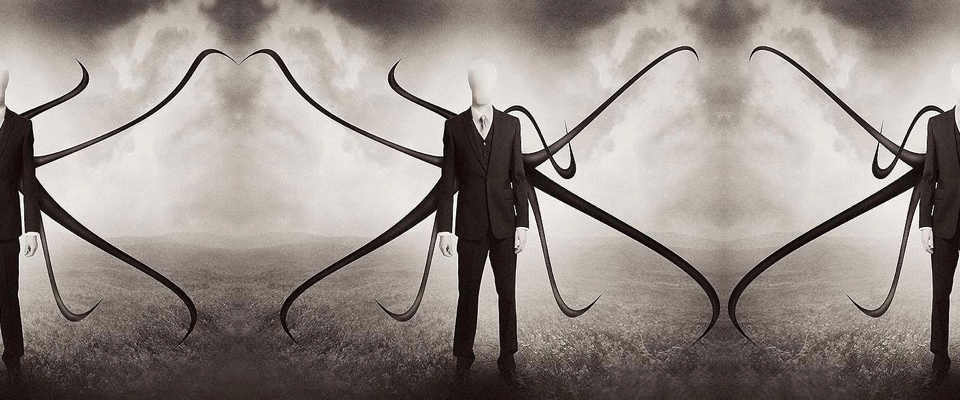In 2014, Slender Man, the shadowy Internet meme in formalwear who inspired two 12-year-old girls in Waukesha, Wisconsin to lead their friend into the woods and stab her 19 times, caused a widespread panic. Adults everywhere saw Slender Man’s influence—albeit fictional and web-based—as a potential threat to the wellbeing of their children and themselves. Some were convinced that Slender Man “encourages students to do dangerous things.” Others thought that selling Slender Man costumes supported violence. Even the Waukesha police chief warned ominously that Slender Man was a wake-up call to all parents. “The Internet,” he said, “is full of dark and wicked things.”
Though he’d been around for a half a decade before the stabbing, Slender Man rapidly became the proverbial razor blade in the Halloween candy, an evil incarnate that threatens children.
You see, Slender Man—also known as SM, Slendy, The Pale One, The Thin Man, and my personal favorite, Der Großmann—is deeply
misunderstood.
But contrary to popular parent opinion, Slender Man may not be so evil at all. In fact, he could be just a regular, run-of-the-mill, legendary dude who, because of unfortunate circumstance, got labeled a pariah.
“I don’t think it’s fair,” says UC Berkeley grad and Utah State folklore professor Lynne McNeill. “I think it was an unfortunate timing situation, where Slender Man had been around for five years before [the stabbing] happened, kind of living his own life as a great, legendary character … scaring the pants off of a lot of us, which is great.” McNeill, who coedited the recent book of essays titled Slender Man is Coming, continued, “[Slender Man’s story] is much more nuanced than, ‘Oh, Slender Man is a scourge upon society who made two girls stab a third.’ It’s a vast oversimplification.”
Because most people first heard of Slender Man in the context of the Wisconsin stabbing, it metaphorically and irreversibly slaughtered Slender Man’s reputation, says McNeill—which may not have happened had he been more famous. When it was revealed that one of the 12-year-olds was schizophrenic and talked to Lord Voldemort, for instance, He-Who-Shall-Not-Be-Named’s name wasn’t slandered in every headline. Similarly, when a gunman who called himself “The Joker” shot up a movie theater in Colorado, killing 12 people and injuring 58, the public didn’t blame Batman or comic books—they blamed the shooter.
“I think it would be like if someone murdered a person…in the name of Bigfoot. We all know too much about Bigfoot to think Bigfoot caused that,” McNeill says. “We would attribute that to the individual motivations of a person latching onto a legend inappropriately and for inappropriate ends, but we wouldn’t blame the legend.”
In other words, it may not be that Slender Man influenced the girls, but more that they influenced the Slender Man—a character whose very narrative was written by users like them.
In Slender Man lore, he’s often portrayed as a fantasy rescuer of the bullied. Only he doesn’t just stop the bully…but violently destroys him and tears him to shreds.
You see, Slender Man—also known as SM, Slendy, The Pale One, The Thin Man, and my personal favorite, Der Großmann—is deeply misunderstood. And not just because he was in the wrong girls’ heads at the wrong time, but because his actual backstory is confusing as frick. (Yes, I said frick.)
Slender Man originated on the forums of the humor site Something Awful back in 2009, when a guy named Eric Knudsen tried to win a spooky photo contest. He posted a couple of seemingly normal black and white photographs of children playing that, when examined more closely, had an inexplicable, long-limbed figure in the background. And thus the Slender Man was born. Just two pictures were enough to capture an audience, and people started imagining what he’d be like in person. Imagine a sort of Tinder-for-Monsters situation: “Why hello Mr. Tall, Dark and Slender Man! I wonder if he likes froyo and Game of Thrones…”
For the next eight months, Slendy’s story was widely shared around the Internet a la “creepypasta”—a term that originated from “copypasta,” a block of text that gets copied and pasted from website to website. To make a creepypasta, users—often teens and tweens—share and reshare horror stories with new terrifying narrative additions, original images, and video to add to the lore. It’s kind of like fan fiction from hell, where users—creepypasta chefs, if you will—cook up stories that everyone knows are fake…yet seem just real enough to keep them up at night. Hence the name of reddit’s creepypasta forum, No Sleep, where the description reads, “Everything is true here, even if it’s not.”
Slender Man has long been associated with creeping out children specifically, so parents have even more reasons to want him purged from the net. He may just exist for entertainment, but that has never seemed to matter. Lest we forget the Devil’s music of the 1980s? Or the arguably more horrifying Satanic beats of today?
What makes Slender Man different from most other bogeymen is that he’s largely a creation of the very minds he terrorizes; i.e., youngsters are willing participants in his narrative development, adding their own sauce to the creepypasta, if you will.

“Young people on the Internet are making art and writing fan fiction, looking at these Photoshops and being interested in creepypasta. We don’t have quite the, ‘Who is the nefarious bad guy perpetuating this dangerous content?’ situation [with Slender Man],” McNeill says. “No, this is the ultimate in nefariousness; young people are promoting this content for each other and for themselves—and look what’s happening.”
In the case of the Wisconsin stabbing, the girls created their own backstory around Slender Man in which he became their ally. They wanted to murder their friend in exchange for becoming SM “proxies,” servants that do Slender Man’s bidding. According to the girls, if they were good, he would promise not to murder their families and allow them to come live with him in his demonic mansion in the middle of the woods. The girls feared Slender Man, but they also wanted him as a protector.
This isn’t so uncommon in Slender Man lore, where he’s often portrayed as a fantasy rescuer of the bullied. Often in SM fan fiction, when a child is being picked on, they call upon Slender Man and he shows up to stop it. Only he doesn’t just stop the bully…but violently destroys him and tears him to shreds. Afterward, McNeill explains, the protagonist—shocked and upset—wonders: Is this really what I wanted? Is this justice?
“We see the ambivalence of childhood taking center stage in current Slender Man lore,” McNeill says. “Children really negotiate with and work through a lot of the scary elements of the world through their folklore, through their play, through their conversations with their friends—and it’s an infinitesimally small number that go out and commit heinous crimes because of it. It just makes huge news when it happens.”
Slender Man is, in fact, closely linked with bullying. When East Carolina University folklorist Andrea Kitta studied what, in Slender Man fiction, is known as “The Sickness,” aka “Slender Sickness”—a set of physical and mental “symptoms” that occur when Slender Man is nearby—she interpreted it as a creative way in which some kids process their trauma.
Of course, good ol’ Der Großmann isn’t always a brutal best bud. Kitta says that while Slender Man is a protector, he’s also “the face of cyberbullying” itself.

“[Slender Man functions], in a lot of ways, just how cyberbullying functions, where there really is no break from it,” Kitta said in an episode of the Folklore Podcast. “It used to be that you would just go home and you’d get away from your bully, but that doesn’t happen with cyberbullying…it’s everywhere all at once…just like Slender Man.”
And that “everywhere at once” nature of SM isn’t only scary to kids. Among adults, McNeill says, it taps into a fear of constant surveillance—like what we experience from the NSA, Google, Alexa, [insert tech product name here]. (Personally, it sends chills up my spine when Amazon suggestions know me better than I know myself.)
“He’s not overtly threatening us, just sort of implicitly being present. To me, that’s just such a clear representation of a corporate culture that’s infiltrating what we think of as the noncommercial spaces in our lives…If that’s not major shopping websites, I don’t know what is,” says McNeill. “We are collectively very interested in surveillance culture and corporations’ drives to observe us, reach out, and lure us in.”
So without doing a thing, Slender Man has become a supreme manifestation of our modern fears and anxieties—and the scapegoat for them, too. McNeill calls him “a perfect monster for our time.”
Not to mention the recipe for Slender Man’s creepypasta was downright exquisite, which makes him extra freaky. The ability to create the perfect creepypasta is like a new artistic skill—it requires the story to provide just enough detail and leave just enough unknown to seem real even if we know it’s fake, says McNeill. That’s what makes creepypasta different than say, a fantasy TV show.
Take, for instance, The Gentlemen, the fan-favorite monsters in Buffy the Vampire Slayer who share a lot of similarities with Slender Man. They’re tall, thin, white-faced men in suits who like to harvest people’s organs and stalk them while they sleep. But unlike The Gentlemen, Slender Man was never featured in the opening credits of a well-produced show with a rad theme song by Nerf Herder. Instead, his story was slapped together haphazardly and over time by a bunch of different people. This low production value paired with the gaping holes in Slender Man’s narrative make him much more believable as a real entity, says McNeill. Reality doesn’t give us clear and tidy answers, so we’re more likely to believe the imperfect.
Without doing a thing, Slender Man has become the manifestation of our modern fears and anxieties—and the scapegoat for them, too.
“If something is too perfect, we might still like it, but we understand it to be fictional,” believes McNeill. “Reality is rarely clean cut and has a high production value. We believe in something filmed on a cell phone much more than we believe in something obviously filmed through a multi-camera, multi-angle approach on a soundstage.”
And now that the professional, Hollywood-caliber Slender Man movie is out, he seems even less real—and has nearly fallen off the face of the Earthlink. (I know, I can’t believe Earthlink still exists either.) The fun of creepypasta is to create a monster that seems real even when you know it’s not, and when Google is flooded with headlines talking about how fake ol’ Slendy is, it takes the magic away a bit. He lurks in the dark corners of the net where some diehard fans keep his story alive, sure, but the poor guy isn’t flourishing as much as he once was.
“I think the moral panic around Slender Man…if it’s done anything, it’s made him seem more fictional. That usually siphons power away from a figure like that,” McNeill says. But, she adds, the myth may still captivate “kids who aren’t reading the news and watching the headlines the way their parents are.”
While McNeill thinks that Slender Man was unfairly blamed for the stabbing (the victim survived, by the way), she says that the question of what children should be reading or watching is important to consider. Some studies have shown that exposure to violent media influences children to act more violently. And, McNeill says, people shape Slender Man into whatever they want him to be—whether that’s fake and harmless or real and scary. Even if Slender Man is fictional, how much more real does he have to be if tweens are stabbing each other in his name?
As Something Awful user Soakie said in a post in 2009:
“[Slender Man] is a satisfactory booger [sic] man, pressing all the right buttons. Even if we don’t really believe in the supernatural, even if our rational minds laugh at such an absurdity…we are cutting him out and sewing him together. We’re stuffing him with nightmares and unspoken fears. And what happens when the pictures are no longer photoshops?”
Here’s hoping we never find out.
Krissy Eliot is senior associate editor at CALIFORNIA. You can find more examples of her work and her contact info at www.krissyeliot.com.



















